Searching for ‘green’
Posted in 2010-2019, Editorial blog posts, entertainment, gardens, Green, Places, public squares, Stories, Strandlines, Strands, streets and roads and tagged with climate, environment, green, London, map, northbank, pollution, tour, walking, Westminster
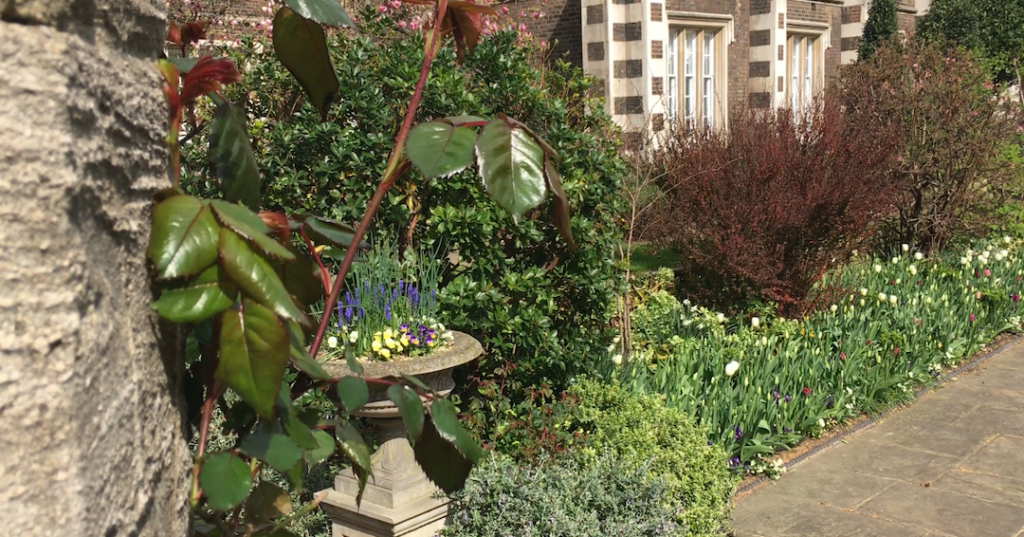
The Northbank Bid have collaborated with Groundwork and King’s College London scientists to suggest ‘Green Walks’ around the Strand area. You can download the map with suggested loops and routes from the Northbank website.
The idea is to help Londoners and tourists to avoid the most polluted streets as they travel from A to B: one route from Embankment to Covent Garden apparently cuts average pollution exposure for a commuter in the area by 47%. But the routes are also to encourage people living, working, or studying locally to take time to explore greener spaces during their lunchbreaks or weekends.
Featured image: a ‘secret’ garden in Middle Temple.
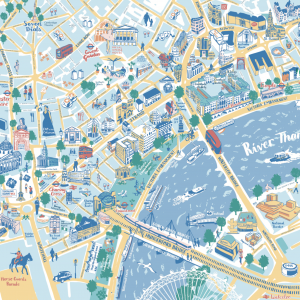
The Northbank Bid / Groundworks map of the Strand area, via Northbank website.
Last month I went along to one of the Northbank Bid’s guided ‘Green Walks’, led by Living London founder Saira Niazi. As a long-time worker on the Strand (I started my studies at King’s in 2008), I was curious to discover new routes.
We started in the Somerset House courtyard before venturing down to the cool, dark basement level of the old palace, to emerge on the sunny Embankment. We’d been asked to think about green space and pollution as we walked, which made the blast of noise and dust all the more noticeable.
I remembered how, in the first year of my PhD in 2016, I tested out the newly-opened Embankment cycle superhighway. It struck me then, and now, that although the kerb separates bikes from vehicles, the choking fumes still prevent serene enjoyment of pedal-power under the plane trees, beside the glittering river. With builders working on Somerset House’s façade to the left and enormous articulated lorries to the right, this stretch of the tour didn’t feel so ‘green’!
The garden around Temple Station provided relief, and we paused to admire the lush foliage contrasting with the austere Portland stone of Two Temple Place.
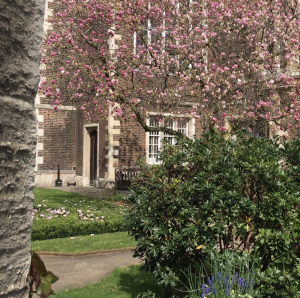
Middle Temple spring blossom.
Our wanderings then took us almost beyond ‘Strand’ limits as we explored Middle Temple gardens, clerks criss-crossed infront of our lazier pace (with airplanes buzzing over head). A group of Spanish-speaking students stretched out on benches on one of the Temple’s hidden lawns, surrounded by the first buds of summer border shrubs.
Emerging back onto the Strand via Devereux Court and Essex Street, onto the broad Aldwych sweep, I imagined what it might be like when the south side of the road becomes pedestrianised. I’m particularly looking forward to the little island of St Mary le Strand being brought back into communion with footpaths and strollers: I’d love to prop myself against the heat-absorbing cream-coloured stone on a spring day such as this one, shoes off, snatching a break between teaching or writing.
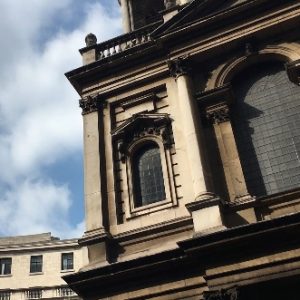
The stone of St Mary le Strand warming in the sun.
We moved west and north, crossing the Strand and passing the Lyceum theatre to edge Covent Garden’s south side. We gathered in Nell Gwynne alley, shuffling close together to leave space for those already in the know of the shortcut. Here, too, the air didn’t feel particularly fresh, but Saira’s stories of showgirls and clowns from London’s theatre history layered the passage, stuffy and noisy with the whirr of extractor fans, with some romance.
A final cut across the Strand led to the side of the Coal Hole pub (built in 1903 as part of the Savoy Hotel estate), down the steps of Carting Lane and across Victoria Embankment Gardens, with a final stop at Cleopatra’s needle to listen to stories of Southbank mudlarkers. I especially enjoyed hearing about the message-in-a-bottle finds collected by Nicola White from the Thames shores.
Toward the end of the tour, I asked Saira what her favourite parts of the Strand were. She recommended the India Club, both as a place to grab a tasty meal, but also a place holding stories of migration and community (and, it’s under threat – see Clare Brant’s post for Strandlines explaining how you can help save it, and read more about its history on the National Trust’s mini site). Saira also reflected on the importance of Trafalgar Square as a place of protest and partying, from the St Patrick’s Day parade to Eid celebrations (in fact, next week you can join the Vaisakhi festival – see the London gov site for more!). And I have to agree with her – it is remarkable how perhaps the city’s most central plaza can still sometimes feel as intimate as a garden or living room.
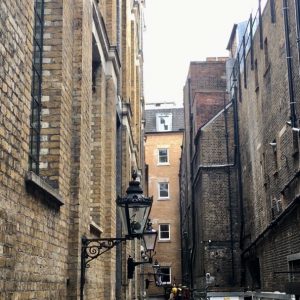
The Nell Gwynne alley.
For the fleet-footed walker, these shortcuts offer a little escape from the crowded pavements. However, the tour route had me wondering about the options for cyclists and other folks who can’t do stairs – so many of the green spaces and quieter pedestrian routes are off limits to them.
I also wondered about how the Strand itself could become ‘greener’. Having walkers abandon the Strand should only be a short-term work-around as we find ways to make the thoroughfare itself more welcoming.
The Northbank Bid have some ideas about how non-drivers can help to reduce traffic – for instance, office workers might get deliveries sent home or use ‘click and collect’ instead of ordering parcels to their desks. But still this leaves so many taxis and ubers to contend with.
Since the ‘green walk’, I’ve been daydreaming about a tunnel under the Strand to join with the Lancaster Place – Kingsway underground bypass of Aldwych. Would that help ease congestion, or just make the car journeys unbearable? It also adds to my picture of the Swiss Cheese subterrain of London (no engineer can convince me of why the pavements don’t cave in, being so drilled through with trains and escalators and sewers). I have fond memories of cycling down the Strand after very late nights – at 2am the air is markedly more breathable, the pavements swept and washed by the busy cleaning teams, and the first stirrings of birdsong can be heard before the traffic roar recommences.
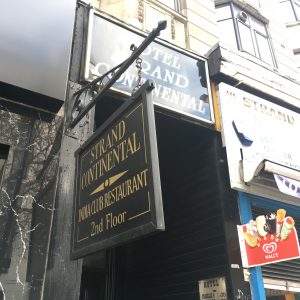
The Strand Continental India Club at 143 Strand.
But perhaps the best pedestrian Strand memories for me are the protests – you realise how much is given over to cars and engines when suddenly you can reclaim that space as you march (and infact, researchers have found that this month’s Extinction Rebellion occupations have reduced pollution on the Strand!). What sustainable ways might we find to make the Strand more healthy, beautiful, and useful?
Do you have any shortcuts around the Strand? Do you have a memory of walking, cycling, or otherwise moving down the Strand and breathing more easily? Share your memories in the comments below, or on our Facebook or Twitter pages, using the tag #MyStrand.

